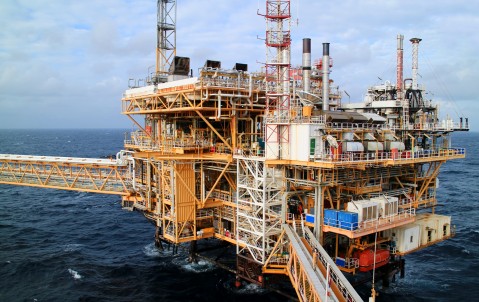
Packing up after the oil rush
With world oil production forecast to peak in the coming years, decommissioning is set to be the new boom.
Since black gold was struck in the North Sea in the 1970s, 42 billion barrels of oil have been sucked out from below its seabed. But the task now is to dismantle the giant platforms that for decades drilled and pumped round the clock. Extracting oil and gas in such hostile waters is a high-risk business, not to mention dismantling and cleaning up afterwards.
Six hundred ageing oil and gas platforms are due to be taken apart by 2021, with a further 2,000 set to be removed worldwide between 2021 and 2040, according to the Offshore Decommissioning Study Report. Spending on decommissioning is set to increase to $13 billion a year in 2040, an increase of over 500% on 2015, it states.
Roughly half of that will be spent on dismantling North Sea structures.
Spending on decommissioning is set to increase to $13 billion a year in 2040, an increase of over 500% on 2015.
The first North Sea platforms were built in a hurry in the midst of a global oil crisis more than 40 years ago. There was little consideration of what would happen to them when their working lives ended. Nearly as tall as the Eiffel Tower from their huge reinforced concrete feet far below the sea surface to the tips of their derricks and weighing nearly as much as the Empire State Building, they were never meant to be dismantled, their operators argue.
The idea of removing such huge structures would have been unthinkable until fairly recently. But governments, spurred on by an increasingly environmentally conscious public, are now demanding companies leave behind virtually nothing of the equipment they used to drill, extract, process and pump the crude oil in the North Sea.
A crude task
The scale of the task is mind-boggling: thousands of wells must be capped, hundreds of platforms taken away and thousands of miles of pipeline broken up. It could take up to four or five decades to complete and the cost is huge: somewhere between £39 billion and £60 billion, it is estimated, with the UK government offering generous tax relief to help offset the cost to the oil and gas companies.
The idea of removing such huge structures would have been unthinkable until fairly recently. But governments are now demanding companies leave virtually nothing.
Decommissioning has already begun. Larger companies put their plans on hold when the oil price plummeted from $115 a barrel to less than $30 in early 2016, but now the oil price has recovered, political pressure is growing for the cleanup process to begin in earnest.
A risky business
Dismantling platforms (also known as topsides) that have served for decades as a combination of factory, power station, processing plant and hotel for hundreds of workers is no mean feat. They have been taken apart gradually like huge Meccano models, however new technology and techniques are being developed which are expected to make the job safer and more efficient.
An ambitious new solution is to lift and remove the platforms in one piece, which has given birth to the world’s largest ship, the Pioneering Spirit. Built at a cost of £2.4 billion to lift entire topsides weighing up to 48,000 tonnes; it is as long as six jumbo jets and as wide as three football pitches. Its twin hulls are 59 meters apart, creating a huge slot into which the topside fits, which is then lifted onto its deck using eight sets of arms weighing 2,000 tonnes each.
In May 2017, it lifted the Brent Delta topside – at 24,000 tonnes the heaviest offshore lift so far – and sailed it over 400 miles to Hartlepool to be broken up.
The Pioneering Spirit cost of £2.4 billion and is as long as six jumbo jets and as wide as three football pitches.
In the unforgiving North Sea, dismantling these giant structures poses a mountainous challenge in the form of 100-foot waves and 50mph winds. Although the final lift of Brent Delta onto Pioneering Spirit was done in seconds, it took two years before that for it to be cut carefully away from its enormous concrete legs and for 1,500 people to weld steel to its undersides so it wouldn’t disintegrate when lifted onto the vessel.
“The scope for mishaps in such a complex engineering challenge is enormous,” says Rachel Pereira, Energy Underwriter at Hiscox London Market. “They range from major disasters like the topside falling apart when it is lifted or simply toppling over when cut away from its legs, to the discovery of hazardous materials that require special removal.”
Complicating the process further is that many topsides have been added to during their lifespans. “No two platforms are the same,” says Charles Rawlins, Energy Line Underwriter at Hiscox London Market. “There is no standard way of decommissioning them. Their condition, weight and construction is always slightly different, so the engineering test in taking each one apart is unique.”
The scope for mishaps in such a complex engineering challenge is enormous...like the topside falling apart when it is lifted or toppling over when cut away from its legs
The operator or its contractor won’t be fully aware of what state the platform is in until the decommissioning process begins, so the scope of the work required can change quite dramatically from what was originally planned, says Pereira.
Once the topside has been dismantled, removing the legs (or ‘jacket’) and the huge plinths on which they sit can be as big of a challenge, Rawlins adds. “They can be of steel construction secured by piles driven deep into the seabed or concrete gravity structures which are even heavier and harder to remove.”
New rules, more scrutiny
International rules put in place after the 1995 outcry over Shell’s plan to sink its Brent Spar oil storage tower require companies to take away almost everything when the oil and gas has run out. Shell applied for an exemption from these rules for its plans to decommission the Brent field, arguing that leaving the 300,000 tonne plinths on which three of its platforms stood would be the safest and most environmentally-friendly option. Green groups protested vociferously.
Tougher regulation and growing environmental concerns over how ageing oil and gas assets are disposed of have intensified the scrutiny on companies’ methods and increased the risk that they might be forced to revise or even rewrite their plans, as Shell did for Brent Spar. (Instead of being towed into deep water and sunk, as originally intended, it eventually became part of the foundations for a new ferry terminal in Norway.)
The slow and hazardous work of taking down old oil and gas structures is fast becoming a growth business.
Problems ranging from boycotts and bad weather to ecological protests and technical challenges could lead to lengthy delays that can play havoc with a company’s profits. Hiscox is leading the way in this emerging risk by developing policies that protect oil and gas companies and contractors from unexpected snags that could force them to go over budget. It also offers protection for liabilities and physical damage arising out of decommissioning work. “We offer them financial certainty on the overall price by compensating them for any unforeseeable extra costs,” says Rawlins.
The slow and hazardous work of taking down old oil and gas structures is fast becoming a growth business. Before, the pressure was to find and extract the oil. Now it is to leave the former oilfields in their natural state. But just like prospecting, decommissioning is a risky venture, with plenty of unforeseen problems, just without the chance of striking it rich.



